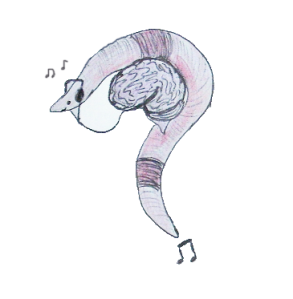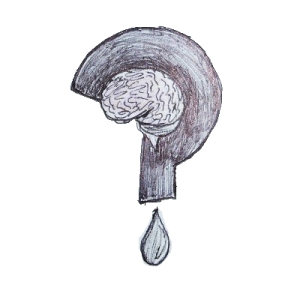
‘You’re doing it again…’
Oh.
‘Sorry.’
Hmm, now where was I? Oh yes… Interrupted, I return to my train of thought as I go back to minding my own business. The trouble is, it starts to happen so softly, so imperceptibly that I don’t even realise, and before I know it I’m –
‘Shut up!’
‘Sorry!’
– unashamedly full-blown whistling Chopin’s nocturne in E flat major for all around me to hear. Again.
Something sinister is stirring in the auditory cortex, but you’ll be relieved to know that the worms we’re discussing are not of the vermicious kind (‘of, or pertaining to (wriggly) worms’ – since you were wondering. Aren’t words great?) but are instead, of the musical variety.
The term ‘earworm’ comes from the German word Ohrwurm, and refers to the strange but common phenomenon of experiencing episodes of persistent musical imagery: having a tune ‘stuck in your head’. We probably all know this feeling: that one little snatch of a song that keeps going round and round in your head and just won’t go away; but have you ever wondered why this happens? How can we be ‘hearing’ something that is just in our heads and isn’t physically a sound? And what purpose – if any – does it serve?
Earworms are a subject near (frequently!) and dear to my brain, so naturally I was delighted to discover that they are actually an area of legitimate scientific study. My long-suffering dad has often likened life in our house to being the owner of a jukebox except that you don’t get to pick any of the songs, and it won’t turn off – such is the extent to which my sister and I are plagued by earworms. It’s often been the case that I’ll suddenly realise I’m humming something, pause in confusion wondering when I’ve heard it recently to have picked it up, only to hear an off-key, yet commendably enthusiastic humming of the very same tune drifting across from my sister’s room! (Whilst I was at home for the Christmas holidays I noticed that a slightly disturbing mash-up comprised of Liszt’s ‘Hungarian Rhapsody’, songs from ‘Les Misérables’, and the more festive ‘Baby, It’s Cold Outside’ seemed to have taken root in the Casterton household…)
Perhaps alarmingly, much of what we know about earworms comes from the considerable research effort of the advertising industry. The motive behind this is obvious if not slightly sinister, you need only think of the most legendary advert jingles which have wormed their way into our collective memory to see the power behind being able to understand how musical imagery works. Research in this field aimed at marketing suggests that music that is simple and repetitive (and therefore easy to remember) yet has an unexpected variation in rhythm is more likely to become an earworm, as it is thought that they can be triggered when we subconsciously detect something unusual about a piece of music.
From research it’s thought your average earworm is a 15-30 second loop, but can be longer. The type of music that makes an earworm varies widely, generally depending on the sort of music you’re exposed to as a result of culture and personal preference. In one study pop music, film scores and – interestingly – Christmas songs were amongst the types of music most reported as earworms. I can certainly sympathise with this as my own earworm repertoire more often than not consists of classical music, and most notably film scores. In fact, as I write this my earworm du jour happens to be the ‘Jurassic Park theme’ composed by John Williams (which I have to say, has actually been quite motivational!) And I’ve been reliably told that I was insufferable to live with in the week after I saw the first Hobbit film.
So, what is going on in our brains? How on earth can we be ‘hearing’ something that’s not physically a sound? The important yet baffling thing to understand about earworms is that they really are just in your head. When you’ve got a song on the brain there is nothing physically going on in your ears, there is no sound energy corresponding to the music you’re ‘hearing’ displacing air in a wave and hitting your eardrum.
Frustratingly, earworms as an area of science is one that researchers are only just starting to delve into properly, and so little systematic investigation has been carried out. Most studies so far seem to be concerned with the ‘what’ rather than the ‘how’ or ‘why’, and generally involve questionnaires or ‘earworm diaries’. These unfortunately are rather subjective methods which rely on your volunteers being able to accurately judge when an earworm episode starts and for how long it lasts. Being one yourself, you’ll know that humans are often prone to…well, human error, and poor judgement.
However, there is a rather simple yet clever experiment that has provided some promising information about what’s going on when we’ve got a song on the brain. A study conducted by David Kraemer and other scientists at Dartmouth College, USA used fMRI (functional magnetic resonance imaging, which produces an image based on the principle that more blood flows to more active areas of the brain) to observe the primary auditory cortex and auditory association cortex of volunteers. The subjects were played songs from their own unique playlists selected by the scientists, which contained some songs which were known to the person and some which they’d never heard before. The nifty bit is that, unbeknownst to the people in the scanners listening to their songs, the researchers had inserted gaps of silence lasting 2-5 seconds in the middle of songs beforehand.
Interestingly, activity was seen in the auditory association cortex during the gaps of silence, and more activity was measured here during the gaps in familiar songs than in unknown songs. This study is clever because it attempts to side-step the problem that earworms happen spontaneously and are therefore difficult to create in a lab setting (similar to the problem of studying tears I mentioned in my last post). The results of this study demonstrate the compulsory nature of musical imagery: our brains literally can’t help filling in the gaps! True, the unexpected silences in the songs aren’t the same thing as a proper earworm where a snippet of song is repeatedly going around your head, but they do effectively set up an earworm ‘moment’, unlike previous studies which just ask volunteers to imagine a song or note.
So is there method to this musical madness: do earworms have a purpose? One interesting theory suggests that it is a remnant from behaviour in our evolutionary past. Music and songs helped people to remember things and share information before we had invented writing. It’s thought that variations in rhythm and melody provide cues for easier recall; so perhaps when your brain comes across a new rhythm or melody that it notices as unusual it subconsciously initiates mental repetition to ensure it’s remembered? Just think about the power rhythm and music can have in helping us to remember things (altogether now: ‘Mrs B, Mrs E, Mrs A-U-T…’). How many times during your schooldays did you, worn down with revision, bitterly marvel the ease with which you could memorise the lyrics of endless songs yet struggled with those equations? It’s one possible explanation, but for now it seems for a more conclusive answer to the questions surrounding this strange auditory quirk, we’ll just have to wait. But in the meantime, I think I feel a song coming on…
(Don’t be shy – leave a comment and share your earworms, the stranger the better! What’s your earworm of the moment? Do you have any reoccurring ones? Are they enjoyable or just annoying?)
D.Kraemer et al. (2005) Musical Imagery: Sound of silence activates auditory cortex Nature, 434:158

